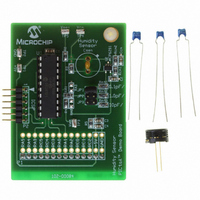PIC16F690DM-PCTLHS Microchip Technology, PIC16F690DM-PCTLHS Datasheet - Page 51

PIC16F690DM-PCTLHS
Manufacturer Part Number
PIC16F690DM-PCTLHS
Description
BOARD DEMO PICTAIL HUMIDITY SNSR
Manufacturer
Microchip Technology
Series
PICtail™r
Datasheets
1.PIC16F690DM-PCTLHS.pdf
(36 pages)
2.PIC16F690DM-PCTLHS.pdf
(32 pages)
3.PIC16F690DM-PCTLHS.pdf
(306 pages)
4.PIC16F690DM-PCTLHS.pdf
(14 pages)
Specifications of PIC16F690DM-PCTLHS
Sensor Type
Humidity
Sensing Range
1 ~ 99% RH
Interface
Analog
Voltage - Supply
5V
Embedded
Yes, MCU, 8-Bit
Utilized Ic / Part
MCP6291, PIC16F690
Processor To Be Evaluated
MCP6291 and PIC16F690
Interface Type
ICSP
Lead Free Status / RoHS Status
Lead free / RoHS Compliant
For Use With
AC162061 - HEADER INTRFC MPLAB ICD2 20PIN
Sensitivity
-
Lead Free Status / RoHS Status
Lead free / RoHS Compliant, Lead free / RoHS Compliant
- PIC16F690DM-PCTLHS PDF datasheet
- PIC16F690DM-PCTLHS PDF datasheet #2
- PIC16F690DM-PCTLHS PDF datasheet #3
- PIC16F690DM-PCTLHS PDF datasheet #4
- Current page: 51 of 306
- Download datasheet (6Mb)
3.3
Clock Source modes can be classified as external or
internal.
• External Clock modes rely on external circuitry for
• Internal clock sources are contained internally
The system clock can be selected between external or
internal clock sources via the System Clock Select
(SCS) bit of the OSCCON register. See Section 3.6
“Clock Switching” for additional information.
TABLE 3-1:
3.4.2
The External Clock (EC) mode allows an externally
generated logic level as the system clock source. When
operating in this mode, an external clock source is
connected to the OSC1 input and the OSC2 is available
for general purpose I/O. Figure 3-2 shows the pin
connections for EC mode.
The Oscillator Start-up Timer (OST) is disabled when
EC mode is selected. Therefore, there is no delay in
operation after a Power-on Reset (POR) or wake-up
from Sleep. Because the PIC
static, stopping the external clock input will have the
effect of halting the device while leaving all data intact.
Upon restarting the external clock, the device will
resume operation as if no time had elapsed.
© 2008 Microchip Technology Inc.
Switch From
Sleep/POR
Sleep/POR
LFINTOSC (31 kHz)
Sleep/POR
LFINTOSC (31 kHz)
the clock source. Examples are: Oscillator mod-
ules (EC mode), quartz crystal resonators or
ceramic resonators (LP, XT and HS modes) and
Resistor-Capacitor (RC) mode circuits.
within the Oscillator module. The Oscillator
module has two internal oscillators: the 8 MHz
High-Frequency Internal Oscillator (HFINTOSC)
and the 31 kHz Low-Frequency Internal Oscillator
(LFINTOSC).
Clock Source Modes
EC MODE
OSCILLATOR DELAY EXAMPLES
Switch To
LFINTOSC
HFINTOSC
EC, RC
EC, RC
LP, XT, HS
HFINTOSC
®
MCU design is fully
PIC16F631/677/685/687/689/690
125 kHz to 8 MHz
Frequency
31 kHz
125 kHz to 8 MHz
DC – 20 MHz
DC – 20 MHz
32 kHz to 20 MHz
3.4
3.4.1
If the Oscillator module is configured for LP, XT or HS
modes, the Oscillator Start-up Timer (OST) counts
1024 oscillations from OSC1. This occurs following a
Power-on Reset (POR) and when the Power-up Timer
(PWRT) has expired (if configured), or a wake-up from
Sleep. During this time, the program counter does not
increment and program execution is suspended. The
OST ensures that the oscillator circuit, using a quartz
crystal resonator or ceramic resonator, has started and
is providing a stable system clock to the Oscillator
module. When switching between clock sources, a
delay is required to allow the new clock to stabilize.
These oscillator delays are shown in Table 3-1.
In order to minimize latency between external oscillator
start-up and code execution, the Two-Speed Clock
Start-up mode can be selected (see Section 3.7 “Two-
Speed Clock Start-up Mode”).
FIGURE 3-2:
Note 1:
Clock from
Ext. System
External Clock Modes
OSCILLATOR START-UP TIMER (OST)
Alternate pin functions are listed in the
Section 1.0 “Device Overview”.
Oscillator Warm-up Delay (T
1024 Clock Cycles (OST)
1 μs (approx.)
Oscillator Delay
2 cycles
1 cycle of each
I/O
EXTERNAL CLOCK (EC)
MODE OPERATION
OSC1/CLKIN
OSC2/CLKOUT
PIC
®
DS41262E-page 49
MCU
(1)
WARM
)
Related parts for PIC16F690DM-PCTLHS
Image
Part Number
Description
Manufacturer
Datasheet
Request
R

Part Number:
Description:
Manufacturer:
Microchip Technology Inc.
Datasheet:

Part Number:
Description:
Manufacturer:
Microchip Technology Inc.
Datasheet:

Part Number:
Description:
Manufacturer:
Microchip Technology Inc.
Datasheet:

Part Number:
Description:
Manufacturer:
Microchip Technology Inc.
Datasheet:

Part Number:
Description:
Manufacturer:
Microchip Technology Inc.
Datasheet:

Part Number:
Description:
Manufacturer:
Microchip Technology Inc.
Datasheet:

Part Number:
Description:
Manufacturer:
Microchip Technology Inc.
Datasheet:

Part Number:
Description:
Manufacturer:
Microchip Technology Inc.
Datasheet:










